Dall Sheep Hunt in the Chugach Mountains of Alaska August 1997
January 23, 2015 2:53 amMy friend Marvin and I left Montana on August 12th 1997 with a VFR Flight Plan filed for the 1 hour flight to Cranbrook, British Columbia where we cleared Canadian Customs. After we landed we were told by FSS to call an 800 number. Everything was done over the phone, no one came to meet us and we were soon in the air again. Marvin is a pilot too so we traded off flying each leg. We had decided to fly up the “trench” through BC and then go over the mountains just south of Mackenzie, BC. I bought all the maps and received as much information about flying to Alaska as I could find during the winter.
The trench is a natural geologic fault line that starts near Kalispell, Montana and runs almost all the way to Watson Lake, Yukon in a straight line. All of it is low in elevation (not over 4000′ msl), lies west of the continental divide, and heads towards Alaska from here. But on the way up we didn’t continue up the trench all the way to Watson Lake. About halfway is Mackenzie BC and from there to Watson Lake is a long leg, about 400 miles with no gas stop in between, no radio contact with FSS, no navaids, or weather reporting. And with any headwind, 400 miles would be pushing our gas supply (36 gal useable and 8-9 gph and 115-120 mph cruise in my Cessna 172). So we went over the mountains to Fort St. John, BC for fuel. This is where the Alaska Highway starts and for the most part we followed the highway to Northway, Alaska. From there we went to Fort Nelson, BC and spent the night. The FBO loaned us a pickup truck and we went to a brand new Best Western on the Alaska Highway. Driving to the motel, a black bear ran across the road in front of us.
Incidentally on our way home we met some pilots from North Dakota in Northway, Alaska. They asked if we’d heard about the bear maulings at the Laird River Hot Springs on the Alaska Highway. According to them, in the time we were in Alaska a big black bear had killed 2 people at these Hot Springs and chewed on a few more. It was finally killed by an American with a handgun that he smuggled into Canada for bear protection. He was the hero but got into big trouble for having the handgun too. Handguns are prohibited in Canada. We flew over these Hot Springs on our way through BC. There is a small airstrip there with a NDB. (I found out later that Montana friend and custom gun maker Jerry Fisher had been there at the time of the bear trouble.)
The next morning we took off for Watson Lake and soon had a 50 mph headwind. Our ground speed was down to 70-75 mph but the distance is about 250 miles so gas wasn’t a problem. Fortunately this area is fairly flat too so the ride was not so rough. But from Watson Lake to Whitehorse, Yukon it gets much more mountainous. It was a little less windy but getting more turbulent in the air. I landed in Whitehorse using their little used crosswind runway, number 19, a combination of gravel and concrete with a “generous over run” as the controller called it. I landed on the “generous over run” which is actually a taxiway to some hangars. The reason I overshot the first part of the runway was because the controller kept warning me as I was in the pattern of “severe down drafts on the approach end of runway 19”. The approach end of the runway sits on a cliff about 300 feet above the Yukon River. The end of the runway sits right on the precipice. And I suppose the air follows the cliff downwards when it blows hard, as it was that day (22 knots as I recall him saying). So I stayed high on final and landed on the “generous over run”. There was no danger really, our ground speed was quite slow with that kind of headwind and it really was a rather generous over run. And I experienced no downdrafts either. Well, that was the most excitement in the air we had on the trip coming or going.
After talking with FSS we decided to spend the night in Whitehorse because of the wind and a weather system that was moving in near the Alaska/Yukon border. No planes were getting past Burwash Landing. Burwash lies about 150 miles west of Whitehorse. The next morning the weather was great and we flew on into Northway, Alaska, which is just over the state line and a common stopping point for customs entry. We had no trouble with customs here either. After the agent learned we were from Montana (he was from Butte) he was more interested in talking about Montana than looking at our stuff or asking questions. We were soon on our way to Palmer, Alaska where I met my sheep hunting guide. The flight through Alaska was great too, mostly through broad valleys. We could even see the Alaska pipeline near Glenallen, Alaska. And on our left we could see the rugged Chugach Mountains where I’d soon be sheep hunting. Flight time was about 20 hours in the C-172H.
I don’t think we ever flew over 6500 feet and when going east we flew at 3500 or 5500 feet. There is not a lot of air traffic in northern Canada or Alaska, but more in Alaska than the Yukon. We could go for hours without hearing another plane on the radio. Surprisingly we met someone I knew from Montana in Whitehorse. I think we saw just 2 or 3 planes in the air while cruising. It is big empty country and both Canada and Alaska require that survival gear be brought on board. We monitored the emergency frequency – 121.5 on the 2nd radio most of the time.
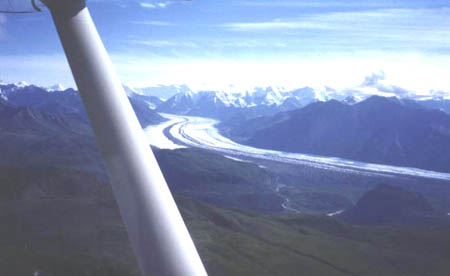
The scenery from the plane was just fantastic. We could always see big mountains and at times flew over them too. Starting in Southern BC there were numerous glaciers and in Alaska some of the glaciers ran for 50 miles or more. I have some good pictures of them from the air.
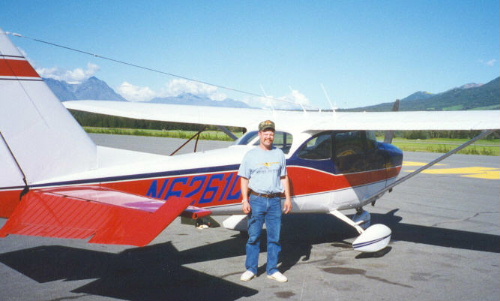
The sheep hunting took place in the Chugach Mountains east of Anchorage. These are rough, high mountains, the youngest range in Alaska. My sheep hunting guide, Dan Montgomery of Wasilla, flew a Super Cub and was very good with it. If he has 200 yards of semi-flat ground (or glacier as I found out) he could land and takeoff. The hunting was both tough and easy. He knew where a good ram was, having spotted him from the air earlier. We put down on a small strip in the mountains the first evening. That night we backpacked our camp about 2 miles closer to the sheep. Early the next morning we set out for the ram having decided on the route from the air the night before. The big rams tend to live by themselves or with one or two other rams in the roughest country they can find.
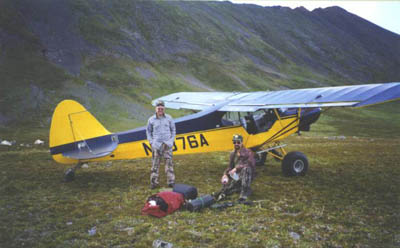
We climbed up some steep rocks to a glacier and then followed the glacier up to its end. It was then about 200-300 feet to the crest but the going got tougher. We had to climb with our hands and feet and pass packs and my rifle between us. Once we reached the top we knew we were close to the ram, if he hadn’t moved. But luck was with me and after only 10 minutes or so we spotted the ram lying in his bed. I looked through my scope and saw that he was looking right at me. I knew I just had a few seconds before he bolted. And I couldn’t get a good rest. I was lying on the sharp knife edge of the ridge with my legs drooped over the side we climbed up and my arms and head pointed steeply downhill, on the other side of the ridge, at the ram with my rifle. He was about 200 yards downhill and I could just see his head, neck and the top third of his back. I quickly squeezed off a shot and missed! We saw the bullet hit high, an inch or two over his back. He instantly jumped up and was out of sight. There wasn’t time to discuss the situation. We both jumped up too and scrambled our way along the sharp ridgeline about 25 yards to our left. Then, there was the ram picking his way through the steep rockslides and boulders below us. I dropped to the rocks again and found him in my scope. I pulled the trigger instantly and down he went. As soon as he dropped he was out of sight but we knew he was hit hard. My guide, Ed, congratulated me and turned to look again where the ram had been. He said “oh no!” I didn’t see it but the ram had just fallen over an edge. As we were soon to find out, he fell a long, long way, about 1500 feet over a cliff and onto more rocks and rough outcroppings below. It took us at least an hour to find our way down to him. During the fall he broke his longest horn. But fortunately the piece was still with him.

We boned him out and packed him on our backs up to the airstrip, about 5 miles from his side of the mountain. After reading this you might wonder why I thought I had an easy time hunting him. Well, the fellow that hunted before me with my guide spent 4 days climbing up and down over this kind of country, spent 2 nights away from camp in the rocks with just a tarp to huddle under. And then had to pack his sheep a long way back to the airstrip. In places they had to use ropes to get up and down steep rock faces. My sheep cooperated and I shot him the first day out and had him packed back to camp that same evening.
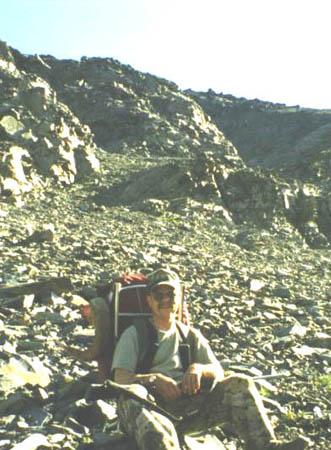
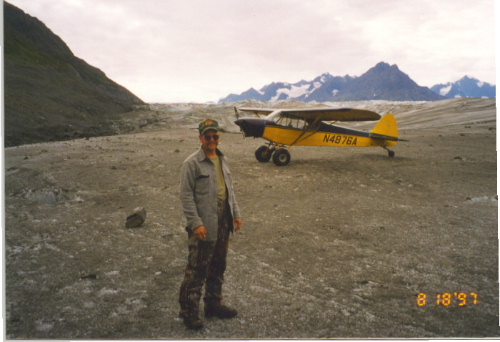
Marvin and I had planned to go caribou hunting on our own after the sheep hunting. He was fishing while I hunted sheep. But the morning we were going to go the weather turned bad to the west. Our hunting area is 300 miles west of Anchorage. Flight Service told us that Aniak had 300-foot ceilings, rain and fog and it was expected to last 3 days or more. From Merrill Field in Anchorage we could see it across Cook Inlet. So we decided to head for home. Reading the paper the next day we saw that Anchorage got 2.5″ of rain after we left. The first day we got to Whitehorse, Yukon. With a little tailwind the next morning we decided to head on down the trench from Watson Lake, bypassing part of the Alaska Highway, and made the 400-mile trip to Mackenzie, BC in 3.6 hours. Poor weather ahead forced us to spend the night there and I was concerned about my sheep meat. I had cut and wrapped it and frozen it back at my guide’s house. But the FBO where we bought gas had 3 big deep freezers in their hangar. They fly groceries to logging camps in the area and have to use the freezers for overnight storage from time to time. They let me put the meat in the freezer. The next day the clouds lifted and we made it into Plains that evening about an hour before dark. On the way home we stopped for customs in Kalispell and had no problems.
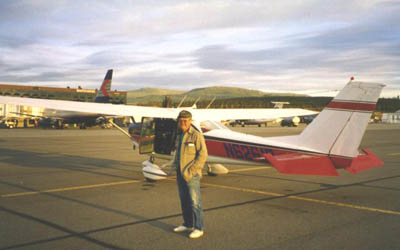
Including a few hours flying time in Alaska after we got there, our total time in the 172 was about 43 hours in 10 days. The GPS system is so superior to all other navaids we didn’t even use the VOR or Loran. But we did use the ADF a few times, mostly to just confirm the direction to an NDB. We never once wondered where we were. The navigator always knew our location to within a few miles on the map. It was a very fun trip, full of adventure and one I would go on again tomorrow. After all, it combined both hunting and flying in some of God’s most beautiful country.

